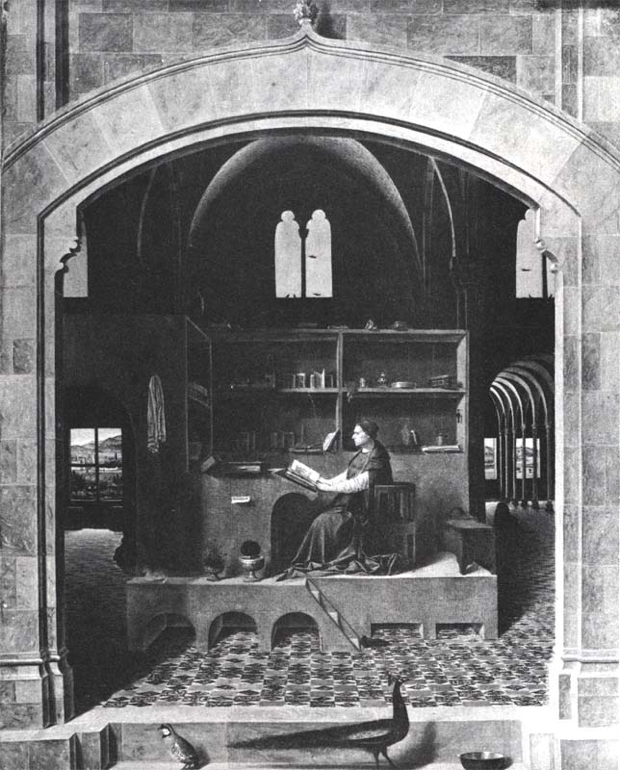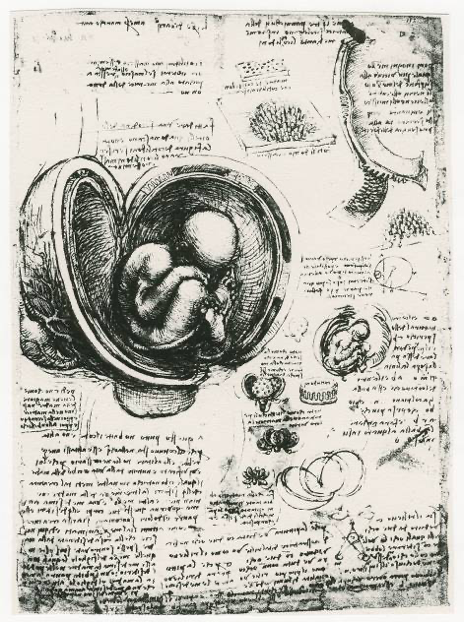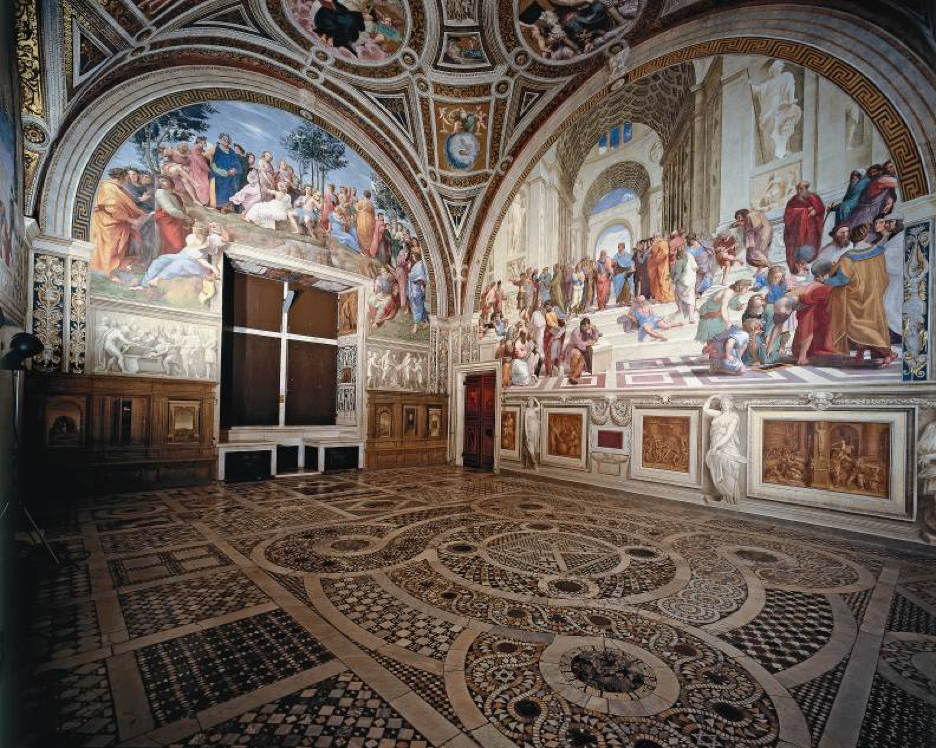5: The High Renaissance (late 1400s through mid-1500s)
( \newcommand{\kernel}{\mathrm{null}\,}\)
Florence and Rome
Leonardo Da Vinci (1452-1519)


Leonardo da Vinci was educated in Florence by the Italian painter and sculptor Verrocchio. Verrocchio, so impressed by his young pupil stated that he would put his paint brushes away after seeing the work da Vinci created. He spent much time in the service of Ludovico Sforza in Milan where he painted The Last Supper. Later, he worked in Florence and Milan again, as well as briefly in Rome. Upon the invitation of King Francis I, he spent his last three years in France, where he died in 1519.
Da Vinci is recognized as a genius skilled in many areas of art, science, and engineering (a polymath). He was an inventor who developed an automated gearing system, helicopter, and other advanced plans that could not be realized because of the technology to build such things was not yet in place. He is known for his notebooks with over 10,000 pages of writings and diagrams in subjects ranging from botany, to human anatomy. Much of the writing is in a form of code to prevent others from stealing his ideas. Even his painting technique remains a mystery, since there is no surviving documentation of his process. His most famous work, Mona Lisa or La Gioconda (1503-1516), displays painting glazes so thin that no brush strokes are revealed. There is much speculation and research about this famous work, even studies using imaging technologies to decipher whether eyebrows and eyelashes were in place at one time. The idea being that the pigments used by da Vinci were phantom pigments that were light sensitive and disappeared over time.
Several painting techniques da Vinci developed greatly influenced future painters. One technique is referred to as chiaroscuro. This translates from the Italian to mean light and dark. It is a technique whereby the forms, whether human figures, landscapes, or objects are revealed by the light falling upon them. By using this technique, the painter achieves painted forms with the illusion of three-dimensions. The unfinished painting Adoration of the Magi, shows the beginning stages of a painting incorporating chiaroscuro. The dark underpainting creates the foundation for the lighter values of paint to reveal light on the forms.

Adoration of the Magi Leonardo da Vinci, 1481-1482 8’ x 8’ 1”
Another painting innovation is the move away from hard edges to reveal forms. We saw in earlier paintings by Italian artists the use of edge-defined forms in the works by Lippi and Botticelli. Da Vinci softens the edges as if we are looking through atmosphere. It is often described as a smoky haze that engulfs the space rendering the forms softer and more delicate. The term for this technique developed by da Vinci is sfumato. A great example of both chiaroscuro and sfumato is the Mona Lisa.

The Virgin of the Rocks, da Vinci, 1485
Much of da Vinci’s work is enigmatic and the source of much controversy and debate. The Virgin of the Rocks uses both chiaroscuro and sfumato creating a three-dimensional illusion on the two-dimensional surface. Using the triangle as a compositional device we see Mary gazing at John the Baptist as she holds him with her left hand while her right hand is placed over the child Jesus. Jesus is giving a blessing to John, while a seated angel engages us through a backwards glance. The angel points to John creating visual movement in the work as we are directed in a continuous circle around the forward space of the grotto. The flowing red cape of the angel is opened up from a movement of air and will be echoed in the paintings of artists like Raphael (see La Belle Jardinière).

St. Jerome in His Study, Antonello da Messina 1475

The Last Supper, Santa Maria delle Grazie, Milan 1495-1498
Note the use of one-point perspective in both da Messina’s painting and The Last Supper by da Vinci.
https://www.youtube.com/watch?v=oa5weji60X8

Vitruvian Man, da Vinci 1487



Mona Lisa, da Vinci 1503-1505

The Mona Lisa used sfumato and the stable triangular compositional device to create a balanced and lifelike portrait unlike any that came before.
https://www.youtube.com/watch?v=NGsUFvwgvCo&t=26s



Embryo in the Womb, da Vinci 1510
Embryo in the Womb is a great example of the sight and insight that de Vinci brings to his work. He is a polymath of the highest order who studies and documents anatomy, designs engineering marvels way ahead of this time, and is also comfortable acting as a diplomatic in politics.
https://www.metmuseum.org/toah/hd/leon/hd_leon.htm
https://www.mos.org/leonardo/biography
https://www.youtube.com/watch?v=VKhBfq4O7-k
https://www.youtube.com/watch?v=NGsUFvwgvCo
https://www.youtube.com/watch?v=13TyiCiOBlI
https://www.youtube.com/watch?v=pN2pPhpAxXk


Michelangelo


Studies for the Libyan Sibyl and Adam, Michelangelo, 1508-1512

Libyan Sibyl, Sistine Chapel, Michelangelo, 1508-1512



One can argue that Michelangelo is the greatest artist of the renaissance. His artistic achievements in a variety of media, his influence on his contemporaries and those who came after, and his longevity and resilience oh helped to establish him as the greatest artist of his time. This is a man who considered himself a sculptor first, and a painter second. Yet, the completion of the Sistine chapel is perhaps the greatest painting achievement of all time. Ironic that while he was painting the ceiling, he felt a great conspiracy against him to keep him from working on his sculptural projects. He hated painting this is Sistine Chapel complaining that his stomach was up in his throat and he was constantly covered with paint. What we see in the Sistine chapel paintings are two different views because there are two separate contacts around the paintings themselves. Prior to the sack of Rome, Michelangelo paints in an exuberant fashion God reaching out to Adam and for the most part lively Biblical stories. However, after the sack of Rome, we Colangelo paints the last judgment on the vertical wall of the Sistine chapel. We see the Christ as the judge her of humankind. Michelangelo places himself in the painting as a flayed piece of skin being held up. This is a tragic event for those damned to hell and Michelangelo does not hold back in showing the judgment of sinners not redeemed by the blood of Christ. Where does he fit in this painting? Well, as he grew older he questioned himself and the work of his lifetime. His later work displays more humility as seen in the Pieta of 1546 where Michelangelo supports the crucified body of Christ.
The young upstart Michelangelo travels to Rome in his early 20s and confidently states that he will create the most beautiful marble sculpture in all of Rome! What is quite amazing, is that he does exactly that. His marble sculpture the Pieta is without a doubt one of the most sublime sculptures ever made. He presents and never used for Virgin Mary supporting the crucified body of her son Jesus Christ. He must exaggerate the size of her lower body and clothing to allow her to support the body of a grown man. This is done in an extraordinary way creating balance, harmony and a quiet beauty to the marble sculpture. Although likely influenced by the Roettgen Pièta that shows agonizing pain, Michelangelo goes in a different direction, creating a work of peace, calm,and beauty.
Back in Florence, there is a large piece of marble over 13 feet tall that a sculptor began working on and abandoned. Michelangelo took on this huge piece of marble to scoped out the David. I working from a scaffold, he chiseled away at this piece in the obsessive way working for weeks without even removing his boots. When he did remove his boots, it’s reported that the skin would sometimes come off with the boots! Michelangelo had to have a misting device falling down upon him as he choose a way to keep the dust and the heat from irreparably harming him. He had to make a wax model and lay it down flat in a container of water whereby the level of water dropping would reveal the next Area to sculpt. This was an ingenious solution allowing him to control the proportions of the David throughout the process. The finished sculpture was meant to go atop the cathedral, but upon completion, the Florentine officials stated that it was too great of work to have so far from my site. Instead the meaning of the piece changed as it was placed in front of the political house of power Florentine. Instead of a top of building of faith. Now, the David represented the people of Florence against the very Medici family he wants adored. For the Medicis had fallen out of favor with the Florentine people at this time and were exerting pressure on the city to comply with their demands. This was due in part by the Florentines exiling the two cousins who Michelangelo grew up with. Do you two cousins, with the support of poke bring an army to subdue the Florentines. The sack of Prado was a warning to the Florentines and the Florentine surrendered to the Vatican army. Machiavelli, had gathered a Florentine force along with supporting individuals from the region to stand up to the Vatican army. However, their army was no match for that of the Vatican. Shortly there after the pope passed away and the new pope was elected by the Vatican council of cardinals. The Cardinal who rose to pope was now pope Leo the 10th, the first Medici poke. With this news, the Florentines welcome pope Leo the 10th back to Florence with a great celebration. The Florentines believed in the infallibility of the pope and excited that one of their own was now pope of the Roman Catholic Church. With the Medici is now in the most powerful position in Italy, Machiavelli reached out to find employment in the new system. However, remembering his role as leader of the antagonistic army gathered together to keep the Medicis from returning to Florence, he was subsequently tortured and exiled from Florence to the countryside. While in exile, Machiavelli wrote the book the prince, as a guide for ruling. In it, Machiavelli spells out strategies to successfully navigate the harsh reality of politics. The book was dedicated to the Medici, but was not well received.
The Medici in their new role as the power brokers of the Roman Catholic Church continue to commission work by the greatest artist of the era. Both Michelangelo and Raphael receive major commissions and work for the Medici pope.
https://dc.etsu.edu/cgi/viewcontent.cgi?article=1009&context=art-appreciation-oer
https://en.Wikipedia.org/wiki/Michelangelo
https://www.getty.edu/art/exhibitions/michelangelo_drawings/explore.html
https://press.princeton.edu/ideas/michelangelo-gave-me-a-new-perspective-on-aging

Pietà, St. Peter’s, Rome Michelangelo 1498

David, Florence, Michelangelo 1501-1504

Moses, S. Pietro in Vincoli, Michelangelo, 1513-1515
Raphael
Raphael had a genius for synthesis. That enabled him to merge the qualities of Leonardo and Michelangelo.

La Belle Jardinière, Raphael, 1507

Frescoes of the Stanza della Segnatura, Vatican Palace, Rome, Raphael 1508-1511

The School of Athens, Raphael 1508-1511

Portrait of Pope Leo X with Cardinals Guilio de ‘Medici and Luigi de ‘Rossi, Raphael 1518
https://www.youtube.com/watch?v=qbceSJtVdws
https://www.youtube.com/watch?v=47nJqQ3Gjx8
Venice:
Giorgione
Giorgione paints scenes related to literary sources. Unfortunately, the sources are not matched to all of the paintings. The Tempest can be interpreted in several ways. One interpretation is that the scene represents the overall feelings that Venetians have at that time. The impending storm approaching the town shows the fragile, unpredictable, and precarious world at that time. The woman and child are exposed to the elements with the watchful eye of a man holding a staff. Paintings like this require the viewer to respond by either appreciating the allegory or solving the riddle. The paintings are not taken literally but relate to the lifestyles and narratives of this place and time.
We also see a painting style being established by Giorgione and further developed by Titian and other Venetian painters. The Venetian paintings are rich and vibrant utilizing techniques of transparent oil painting glazes producing great depth and luminosity. These trademarks of Venetian painters will be appreciated and copied for many years.
https://www.youtube.com/watch?v=3McMcZ4MmKo

Fête Champêtre (Pastoral Concert), Giorgione, 1509-1510

The Tempest, Giorgione, 1505

Bacchanal, Titian, 1518

Madonna with Members of the Pesaro Family, Santa Maria Gloriosa dei Frari, Venice, Titian 1526

Man with a Glove, Titian, 1520


